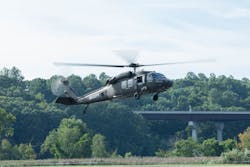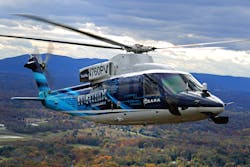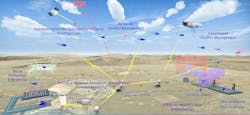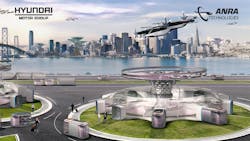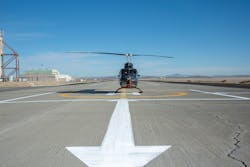Enabling technologies for urban air mobility
By Megan Crouse
NASHUA, N.H. - Automated low-altitude unmanned aerial vehicles (UAVs) within urban and suburban areas: the legendary “flying cars” or passenger drones are always just on the horizon.
Today’s self-driving vehicle technology makes this seem more plausible, even as it has always been a science fiction staple. But industry is taking steps to make it a reality.
What is urban air mobility/advanced air mobility?
The Federal Aviation Administration (FAA) in Washington is taking the notion of urban air mobility (UAM) seriously, too, or at least beginning to set up laws related to it. The FAA defines UAM separately from advanced air mobility: “UAM will be composed of an ecosystem that considers the evolution and safety of the aircraft, the framework for operation, access to airspace, infrastructure development, and community engagement,” FAA officials say.
Advanced air mobility (AAM), on the other hand, adds some more capabilities on top of these. AAM includes commercial use like inter-city, long-range trips, cargoMilitary and commercial applications are being built at roughly the same time, with different teams working to see who will field a practical application, and when. In 2020, Sikorsky, a Lockheed Martin company, tested supervised autonomy, trajectory following, and obstacle avoidance on a UH-60A Black Hawk helicopter. This aircraft, retrofitted as the S-70 optionally piloted vehicle (OPV), sports full-authority, fly-by-wire flight controls. It also has been modified in speed, angle of bank, and the addition of more sensors.
Sikorsky also will provide this technology to Erickson Inc. in Portland, Ore., for an Erickson S-64 helicopter designed for nighttime fire fighting missions. In addition, Sikorsky also is partnering with the U.S. Defense Advanced Research Projects Agency (DARPA) in Arlington, Va., on the Aircrew Labor In-Cockpit Automation System (ALIAS) — a tailorable autonomy kit for installation in fixed-wing airplanes and helicopters. Company officials say they plan to keep testing this through 2022.
Jonathan Hartman, strategy lead for Sikorsky Innovations, detailed some of the Matrix project and his experience in UAM. Military and commercial applications “share a common goal, which is safety, reliability, and assured mission execution,” he says. After all, both applications, whether used in today’s Black Hawk or the next generation’s flying car, need some of the same capabilities: sensing and avoiding obstacles, path planning, interpreting mission goals, re-planning and contingency measures.
The FAA experts still are working on creating new standards and designs to make this a reality for commercial applications. They plan to use existing helicopter infrastructure services, include routes, helipads, and air traffic control services, wherever possible. Among the new standards will be those for new kinds of airports for vertical takeoff and landing aircraft like helicopters.
So far the FAA has a concept of operations written in June 2020 and a partnership with the U.S. National Aeronautics and Space Administration (NASA) in Washington, which is contributing with their Advanced Air Mobility National Campaign.
For its part, NASA has a campaign to “promote public confidence and accelerate the realization of emerging aviation markets for passenger and cargo transportation in urban, suburban, rural, and regional environments.” That refers to local missions of about 50 miles in rural or urban areas, and intraregional missions of as far as a few hundred miles.”
A lot of aerospace companies also are moving in this direction, including Honeywell, Hyundai in partnership with ANRA Technologies, Uber Elevate, and Lockheed Martin and its wholly owned subsidiary Sikorsky.
Real-world experience
Some realistic steps are coming at a broader level. In September 2020 the World Economic Forum and the City of Los Angeles documented principles for adding UAM to existing public transportation offerings. They argued that it would reduce pollution and take strain off of aging ground-level infrastructure. Along with input from a working group of more than 50 manufacturers, service providers, infrastructure developers, academics, community organizations, and government planners, they outlined principles for making urban air mobility a reality. Sikorsky is playing in this same realm with its own UAV efforts to position unmanned aircraft an alternative to lengthy automobile commutes.
International studies such as the WiNDroVe project in Hamburg, Germany, also have taken off — often with Airbus as a partner. In São Paulo, Brazil, AirbusIn Dubai, the city has been testing two-person ‘flying taxis’ run by German company Volocopter. Dubai also put out feelers to share information with the city in Linz, Austria. Market researcher Frost & Sullivan says about 50 cities have some kind of UAM viability project in place, if not the infrastructure and flights.
On the other hand, this potentially revolutionary step in transportation comes with dangers just like any other. In particular, there still is some skepticism as to whether the trend ever will become practical or safe enough for wide-spread public adoption. A Sikorsky S-76 crash leading to the death of retired basketball star Kobe Bryant, his daughter Gianna, and others cast some doubt on personal aircraft safety. Still, crashes never stopped the development of jet airplanes, so this could be seen either as an early warning for more common helicopter-style transportation or simply a tragic and largely independent accident.
Who is working on it?
The other main companies in this area have some interconnection among themselves and with NASA, as it is a relatively small field so far.
One of the first companies to try to make flying cars a reality in the contemporary world was Kitty Hawk in Palo Alto, Calif., backed by Google co-founder Larry Page. Founded in 2010, it has publicly announced three vehicles, including the 2019 Heaviside, which marks its further strides toward the aerial version of an electric car. The Heaviside has a range of 100 miles on one charge and runs more quietly than a helicopter, Kitty Hawk claims. The company’s position as one of the first companies in the field leaves them in an interesting position now, writes Forbes magazine.
At the same time as their name doesn’t come up among the larger aircraft companies’ partnerships and projects, Kitty Hawk also is trying to leapfrog its“It’s a riskier path than going for a piloted aircraft but we believe the payout is 100X of what any piloted aircraft could be in terms of its business opportunity,” Kitty Hawk CEO Sebastian Thrun told Forbes in June 2021.
The U.S. Air Force expressed interest in the commercial Heaviside aircraft for the experimental Agility Prime program in March 2021. Instead of being a combat vehicle, its proposed use would be for medical evacuation missions.
In terms of other commercial aircraft companies, Joby Aviation in Santa Cruz, Calif., and Volocopter in Bruchsal, Germany, “believe they’ll win safety approval for their electric air taxis in 2023,” writes Forbes. Officials of Beta Technologies in Burlington, Vt., say they plan to provide a cargo version of their aircraft to UPS and a passenger version in 2024 to Blade Urban Air Mobility in Denver.
Larger aircraft providers also are feeling out the potential of this new area. Designers at Hyundai Motors in Seoul, South Korea, are working on UAM as one of their future-forward projects, with a goal of commercializing UAM by 2028, officials announced in September 2020. Their project, developed in collaboration with Incheon International Airport Corp. (IIAC), Hyundai Engineering & Construction Co., and KT Corp., involves using UAM vehicles as airport shuttles.
Hyundai has concept designs for this as well, involving vertiports, or ‘UAM-PVB hubs’. The Hubs would be small, airport-like transit centers for personal vehicles in the air and artificial intelligence (AI)-augmented autonomous cars, which would travel in groups and serve as the primary method of ground transportation for the idea. By placing a helipad on top of the hub for the autonomous ground vehicles, the hub ideally would be a relatively compact staging area for several kinds of autonomous travel.
The air vehicles involved would be five-person electric vertical takeoff and landing planes, with one of those seats intended for a human pilot. Hyundai is working with Uber Elevate in the construction of the vehicles.
Like the Los Angeles project, Hyundai posits this as a solution that would cut down on traffic, as well as the associated ‘social costs related to logistics transportation.’ They also foresee it becoming more practical and useful as ‘mega-urbanization’ increases crowds in key high-density areas.
Sikorsky and Lockheed Martin also argue that it would save money, positing an operating cost of $500,000 to $2 million per landing spot for helipads compared to $3 million to $10 million per mile in U.S. urban areas for surface roads in U.S. urban areas.
“Sikorsky is a decade into its journey of developing the enabling technologies with applications to the urban air mobility market,” says Chris Van Buiten, vice president of Sikorsky Innovations. “We were one of the first to quantify the benefits of electric propulsion for vertical lift aircraft. Our MATRIX Technology autonomy system, which is installed on a modified S-76B commercial helicopter, is on a path to FAA certification. And our advanced fleet management technologies leverage data intelligence daily to keep hundreds of our aircraft around the world flying safely.”
Enabling technologies
Data intelligence still must be part of the infrastructure around the autonomous aircraft included in most visions of the UAM future. The MATRIX system for autonomous flight runs on systems intelligence with military and commercial applications. It allows for zero, one or two pilots to take control of the aircraft depending on the circumstance and the application of autonomous flight. When it comes to civilian/commuter transport, all a pilot might have to do would be to communicate with air traffic controllers and watch out for unexpected situations.
Some of the considerations facing electric aircraft are not brand new; after all, safety needs to come first. “Remember, they’re operating in a real-world environment,” Sikorsky’s Hartman says. “Wind gusts, micro-weather, lightning, EMF, all of these fundamental facts of a city infrastructure that are going to impede on your vehicle, the vehicle has to be able to handle that and that all falls under the category of safety. While we’re pushing the limits of technology and battery performance, we can’t do that at the expense of safety.”
Electric propulsion also takes advances of some new developments in batteries, such as solid state electrodes as opposed to the liquid or polymer electrolytes in lithium-ion batteries.
“Technologies like solid state [have] the potential to remove really harmful failure modes like thermal runaway and add performance to the aircraft,” Sikorsky’s Hartman says. “From an electric motor standpoint, it’s more about focus and creating electric machines that can adapt to the air vehicles as opposed to something like cars.”
The change from past traditional semiconductor materials like silicon carbide to semiconductor technology that can take higher voltages and higher amps may unlock greater efficiency for vehicles as power-hungry as an electric aircraft.
“Some advancements in carbon nanotubes are starting to yield benefits in terms of reducing wire weight,” Sikorsky’s Hartman says, “and certainly some of the battery improvements we’re seeing also are making their way over to the fuel cell community because batteries and fuel cells share many of the same components.”
Traffic management solutions
While the autonomous flight element can be used for commercial and military efforts to deploy large, pilot-optional aircraft, the kind of commercial commuter use that really makes up urban air mobility projects as envisioned in cities requires traffic management for groups of vehicles as well as individual capability. Artificial intelligence can come in here, too, with some crossover with companies offering drone aerospace system management and fleet management.
Air traffic congestion comes with other problems as well. Urban air mobility introduces aesthetic and social complications: Will it ruin the view, or cause excessive noise? Will it be allowed to ruin the view in some neighborhoods and not others, the way the placement of highways caused neighborhoods and towns to boom or bust?
For example, a writer for the Thomas Reuters Foundation pointed out in June 2021 that some urban experts say Delhi’s future-city initiative ignores the people who most need help, migrant workers and the poor. Riverside facilities, for example, could deprive farmers who rely on that land of their livelihood.
Sikorsky’s Hartman pointed out that urban air mobility efforts are sometimes a matter of good communication between a manufacturer or project leader and an organization like the World Economic Forum and the cities it touches. While some of this conversation is a matter of not disrupting existing infrastructure, Hartman also imagines it as a way in which to offer better infrastructure for more people, over larger areas — as well as under disaster conditions. After all, medical response or disaster relief could use the same infrastructure as a resource.
“I do believe that vertical mobility actually has an opportunity to be more expansive in inclusiveness than other forms of transportation,” Sikorsky’s Hartman says. “With roads or subways or trains, when you build a mile of infrastructure you connect a mile of geography together. When you put two or three [UAM] landing spots down, you connect a very broad area with limited infrastructure cost. Buses and trains [are] less expensive from an infrastructure standpoint, but you need less infrastructure for the product [with UAM}.”
Timelines and the future
The idea of one pilot, perhaps even located at a central hub on the ground, managing multiple mostly autonomous vehicles in case of emergency is the dream goal for some of these projects. But it will be a while until that becomes a reality.
The World Economic Forum reports that NASA predicts UAM is likely to be a commercially viable market for air metro services by 2028 — that is, as long as federal governments put regulations and policies in place to accommodate it.
In some ways, the infrastructure and capabilities for UAM and AAM are already in place. They’re simply referred to as helicopters. “If you go to NYC today you will see Sikorsky helicopters moving folks around the city,” Sikorsky’s Hartman says. “New technology enables the cost to come down, enable those helipads to be closer to people, allows system to be expanded in through-put. But the ability to move people in three dimensions in highly populated areas such as cities today does exist.”
The big change to come next might be that more of those helicopters are powered by electric propulsion, but to continue to operate in basically the same areas and roles.
Sikorsky’s Hartman casts a bit of a longer timeline than the NASA report, saying that while electrification may become a bigger factor in next five years, it will probably be a matter of decades before we could get to anything approaching a reliable flying car. However, Hartman proposes that some level of autonomy could “reduce the workload on trained pilots such that they can handle more complex situations and contingencies.”
And going from one pilot per vehicle to one pilot handling multiple vehicles also is a matter of cost. “If you look at the economics for UAM, part of how that is how do you reduce cost? The human economics of operating an air vehicle, if you reduce that you see a substantial cost reduction. So it’s not unexpected that there’s many companies in the space that say we’re going to [go from] a fully piloted aircraft, to an operated aircraft, to a sort of tended aircraft, getting to a one to many system. I think we have a ways to go, and that’s a trust factor with the certifications and quite frankly with the OEMs [before we can get there].”
In the end, one of the mitigating factors for AAM and UAM might be a basic human need: trust. Customers, manufacturers and government and/or military clients need to be sure the system is, above all, safe and reliable.
